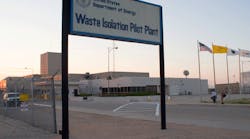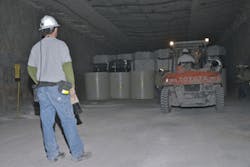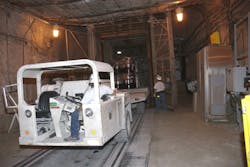The Department of Energy’s Waste Isolation Pilot Plant (WIPP) and Nuclear Waste Partnership LLC (NWP), the WIPP contractor, notified 13 employees of positive preliminary bioassay results from a radiological event that occurred Feb. 14.
At 11:30 p.m. on Feb. 14, a continuous air monitor detected airborne radiation underground. There were no employees working underground at the time, and employees on the surface were sheltered in place as a precaution.
All employees present the night of the event were checked for any external contamination before being allowed to leave the site. As a precautionary measure, the site’s Radiological Control Program also collected biological samples from each of the employees to check for possible exposure from inhaling airborne radioactive particles. Employees working at the site on Feb. 15 were offered bioassay analysis to ensure their health and safety.
Since the event, only essential personnel have been allowed access to the site. Upon leaving the site each individual is checked for any external contamination.
In a letter to the residents in the surrounding area, Carlsbad Field Office Manager Joe Franco wrote, “It is premature to speculate on the health effects of these preliminary results, or any treatment that may be needed.”
The U.S. Department of Energy (DOE) reported environmental monitoring data from samples collected at numerous locations on and around the WIPP indicated slightly elevated levels of airborne radioactive concentrations, which are consistent with the waste disposed of at WIPP. According to DOE, “The samples taken demonstrate these concentrations remain well below a level of public or environmental hazard.”
Dose assessment modeling of the samples, which calculates potential radioactivity exposure to people, shows a potential dose of less than one millirem at each of theenvironmental sampling locations. A person receives about 10 millirems from a single chest x-ray procedure, and the average person living in the United States receives an annual dose of about 620 millirem from exposure to naturally occurring and other sources of radiation.
The material involved in the release event is transuranic radionuclides. The release material predominantly was americium-241, which is consistent with the waste disposed of at WIPP. It is a radionuclide used in consumer smoke detectors and a contaminant in nuclear weapons manufacturing.
Local television station KOB4 quoted Nuclear Waste Partnership President Farok Sharif as saying 100 employees showed up for work on Feb. 27, even though the facility remains closed. “Amazingly enough, my employees are very anxious to get back to work," said Sharif, according to KOB4.
WIPP is a DOE facility designed to safely isolate defense-related transuranic waste from people and the environment. Waste temporarily stored at sites around the country is shipped to WIPP and permanently disposed in rooms mined out of an ancient salt formation 2,150 feet below the surface. WIPP, which began waste disposal operations in 1999, is located 26 miles outside of Carlsbad, N.M.



